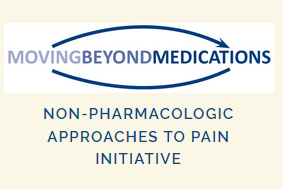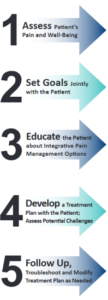Consortia seeks help disseminating pocket-guide on integrative pain options for conventional practitioners
By John Weeks
 by John Weeks, Publisher/Editor of The Integrator Blog News and Reports
by John Weeks, Publisher/Editor of The Integrator Blog News and Reports
The responses to the opioid crisis in the United States have been many. Yet, few have been as practical as the one four organizations that are the leading engines of change for integrative health in the United States recently collaborated to produce. The one-page pocket guide is titled “Moving Beyond Medications.” The resource’s target is conventionally practicing health professionals who may feel trapped in their prescribing of pharma.
The one’s pager’s subtitle is: “Non-Pharmacological Approaches to Pain Management and Well-Being.” The goal is to get conventional practitioners to view non-pharmacologic, integrative strategies as “first-line” responses to pain.
The educational resource can be useful as outreach for any member of the integrative health community. The developers are also urging individuals and organizations to disseminate it widely through their individual and organizational websites.
![]() The collaboration that produced “Moving Beyond Medications” crosses a vast interprofessional spectrum. Members span academic integrative medicine to chiropractic, holistic nursing, nutrition, naturopathic medicine, acupuncture, massage, yoga therapy and more.
The collaboration that produced “Moving Beyond Medications” crosses a vast interprofessional spectrum. Members span academic integrative medicine to chiropractic, holistic nursing, nutrition, naturopathic medicine, acupuncture, massage, yoga therapy and more.
The four collaborating organizations are the Academic Consortium for Integrative Medicine and Health (ACIMH), the Academic Collaborative for Integrative Health (ACIH), the Integrative Health Policy Consortium (IHPC) and the Academy of Integrative Health and Medicine (AIHM). Their logos are banded across the bottom the document, with their websites and an indication that each can serve as an additional resource.
 In an October 2, 2017 letter to members of ACIMH, chair Robert Saper, MD, MPH speak of the “new campaign launched to recommend non-pharmacological approaches as first-line pain treatment, with opioids considered only if these and non-opioid treatments are ineffective.”
In an October 2, 2017 letter to members of ACIMH, chair Robert Saper, MD, MPH speak of the “new campaign launched to recommend non-pharmacological approaches as first-line pain treatment, with opioids considered only if these and non-opioid treatments are ineffective.”
The one-pager outlines a 4-step plan: 1) Assess the Patient’s Pain and Well-being; 2) Set Goals Jointly with the Patients; 3) Educate the Patient about the Integrative Pain Management Options; 4) Develop a Treatment Plan with the Patient and Assess Potential Challenges; and 5) Follow-up: Troubleshoot and Modify Treatment Plan as Needed. Each of the steps is accompanied by 2-4 bullet points of guidance.
The collaborators chose to position their document in alignment with recent Joint Commission guidelines and the Turn the Tide campaign to reduce opioid use of the former US Surgeon General. The document’s recommended approaches “include but not limited to” the following:
- Acupuncture
- Chiropractic, Osteopathic and Myofascial Manipulation, Massage Therapy, and
- Physical Therapy
- Cognitive Behavioral Therapy, Stress Management, and other psychological therapies
- Mind-Body Approaches, Meditation, Biofeedback, Guided Imagery
- Yoga, Tai Chi, and other movement therapies
Saper, the chair of the consortium of 70 medical schools and medical delivery organization then lays down his ask: “We strongly encourage you to send this Pocket Guide to your colleagues, including those who are less familiar with integrative medicine.”
Comment: The leadership of the 4 sponsoring organizations have been meeting quarterly over at least the past year to share strategies and plans. This is the first jointly engaged project. Kudos to leaders of each. As a member of the board of IHPC I have had a chance to observe some of the movement for consensus on language. Fascinating consensus process, not without a few cross-cultural bumps! Kudos to Margaret Chesney, PhD and Bill Reddy, LAc, DiplAc and others who hung in there to get it done.
Now it’s time for the community to get this useful document out there! It’s on the homepage at ACIMH and here at IHPC. My first glance didn’t yet find it yet on the homepages of the others. Consider the reach if each of the 70 ACIMH member organizations, the 40+ ACIH member organizations, the nearly two dozen IHPC Partners for Health each posted this. Meantime, for individuals, a request to the collaborating organizations: will someone please set this up for easy sharing via social media. And how about a join media release? Make it easy!
Editor’s note: This analysis article is not edited and the authors are solely responsible for the content. The views and opinions expressed in this article are those of the authors and do not necessarily reflect the official policy or position of Integrative Practitioner.
















